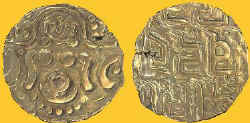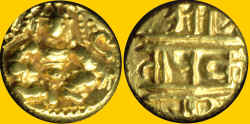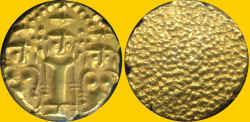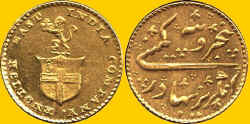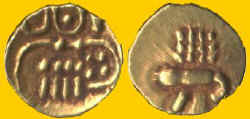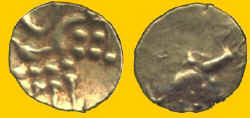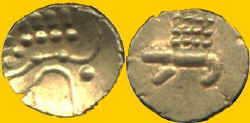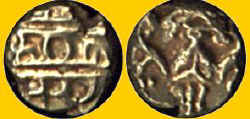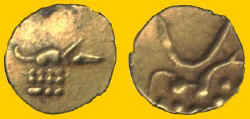This is the Worldwide Numismatics Website!
This is a modest collection of second millennium gold coins of India during the early 19th to 20th Century
Click the thumbnail picture to see a larger version of the picture, then use your browser BACK button to return to the original page you were viewing.
GAHADAVALA DYNASTY
1 Stater - 1114-1154
M-490 - 4,26 g
Edge - Smooth
This debased gold stater was minted by Raja Govinda Chandra of the Gahadavala (Rathor) dynasty in Kanauj and Benares, who reigned from AD 1114 to 1154. This coin is listed in Mitchener's "Oriental Coins and their Values: Non-Islamic and Colonial Series" as M-490. It weighs 4.26 grams. The obverse portrays a four-armed Goddess Lakshmi, seated cross-legged. The reverse bears the Devanagari legend "GOVINDA CHANDRA"
VIJAYANAGAR EMPIRE
1 Pagoda - (1509-1509)
Fr-357 - 3,40 g
This coin was issued during the reign of krisha Deva Raja. The obverse has Balakrishna entrhoned. The reverse has the Devanagari legend SRI PRATAPA KRISHNARAYA.
MUGHAL EMPIRE - KUTCH-BUHJ
25
Kori - YS 1919 (1862)
Y-17 - 4,58 g
Edge - Smooth
This coin was issued in the Mughal Empire independent kingdom of Kutch under Pragmalja III. The obverse has inscriptions in Persian with the date at the bottom. The reverse has legends and date 1919 in Kutch.
EAST INDIA COMPANY
1
Pagoda - (1740-1807)
KM-304 - 3,43 g
This coin was issued in the Madras Presidency by the East India Company. It was minted at Fort St. George. The obverse features three half figures from the 3 Swami Pagoda.. The reverse is granulated.n.
5
Rupees - (1820)
KM-422 - 3,88 g
Edge - Reeded
Mintage - 2,180M
This coin was issued in the Madras Presidency by the East India Company. The obverse features the arms of the English East India Company with the company's name encircling the arms. The reverse has an Arabic inscription.
INDIA (BRITISH)
£1 - 1918-I
KM-525A - 7,99 g - 21,5 mm
Fineness - 0,917 Au/0,083 Cu
Mintage
- 1,295M
The obverse features the large head bust of George V (b1865-d1936). GEORGIVS V D:G: BRITT:OMN:REX:F:D:IND IMP. (George V by Grace of God, King of all the Britons, Defender of the Faith, Emperor of India) surrounds the bust. The obverse was designed by Bertrand Mackennal. The reverse has St. George slaying the dragon. The date 1918 is at the bottom. The mintmark I (for the Bombay mint) is above at the center of the mound. The reverse was designed by Bendetto Pistrucci.
COORG
Fanam - 1600-1834
? - 0,40 g - 8 mm
The obverse pictures a stylised diety and the reverse has a stylized boar. This coin was minted in Kodagu by the Changalva Rajas. These tiny gold coins circulated in South India and Sri Lanka from the 14th to the late 19th century.
KARANATAKA - MALABAR COAST
Fanam - 1638-1834
?? - 0,40 g - 6 mm
The obverse pictures a stylised lion and crescent and the reverse has a boar with short ear and tail. This coin was minted by the Hoysala kings and is the Type II Vira Raya variety. These tiny gold coins circulated in South India and Sri Lanka from the 14th to the late 19th century.
MALABAR
Fanam - 1600
?? - 0,40 g - 6 mm
The obverse pictures a stylised lion and crescent and the reverse has a boar with 12 pellets abovr. These tiny gold coins circulated in South India and Sri Lanka from the 14th to the late 19th century.
MYSORE
Fanam - 1638-1834
Mitchner 1027 - 0,40 g - 6 mm
The obverse pictures a lion head and the reverse has Vishnu. These tiny gold coins circulated in South India and Sri Lanka from the 14th to the late 19th century.
SOUTH INDIA
Fanam - ?
Elliot PL#4 189 - 0,40 g - 8 mm
The obverse pictures a stylised crocodile and the reverse has a stylised lion with note eye and mouth. These tiny gold coins circulated in South India and Sri Lanka from the 14th to the late 19th century.
If you want to return to the the main page, please click here - Main
If you want to return to the home page, please click here - Home
